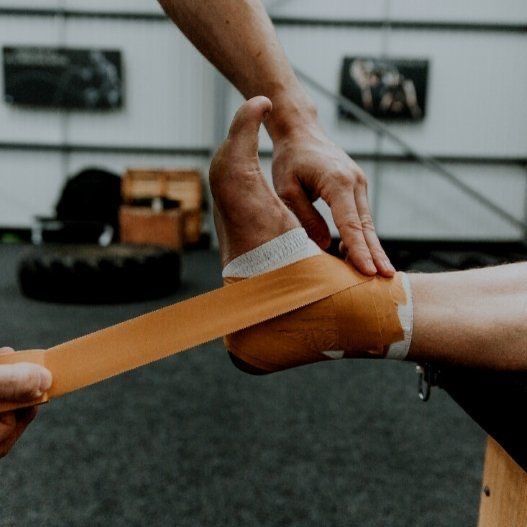Bulletproof Your Body
July 2025 Edition
In this Topic
- Introduction: How Can We Address Injuries Before They Happen?
- The Science Behind Prevention: Train Smart, Not Hard
- Your Injury Prevention Plan
- Ready To Bulletproof Your Performance? Schedule your movement assessment!
How Can We Address Injuries Before They Happen?
Every athlete knows the devastating impact of an injury. It can put you out for several weeks or months which can lead to lost training time, a degradation from performance, and the mental toll it places upon us. But here's the truth about this inevitable thing that can occur at any time: most sports injuries are preventable.
As athletes, we often focus on reactive treatment—and what I mean by this is addressing problems after they occur and not before. But what if we shifted our mindset to having aproactive approach? What if we could identify potential issues before they become season-ending injuries?
This is not just wishful thinking. It's a scientifically-backed approach that's revolutionizing how elite, world-class athletes train, compete, and perform at their greatest. The most successful athletes aren't just the most talented—they're the ones who stay healthy and consistently available to perform.

The Science Behind Prevention: Train Smart, Not Hard
Recent research across many athletes who are involved in contact and non-contact sports like soccer, volleyball, football, running, and dance has shown that they tend to deal with lower extremity (our anatomy addressing the hip and below) injuries like ankle sprains, plantar fasciitis, ACL tears, and achilles tendon ruptures. Like I mentioned, these things are preventable with the an extensive prehab program prescribed to athletes across the spectrum.
Key findings from these recent studies:
- Athletes who followed structured prehab protocols that consisted of plyometrics training and balance training had way lesser injuries compared to athletes who did not follow one
- Neuromuscular training reduced ACL injuries in female athletes being that they are highly prone to this injury compared to male athletes
- Movement screening and corrective exercise programs decreased lower extremity injuries by 39%
The research is clear: preventive training is a no-brainer for athletic success. Athletes from different sport backgrounds who prioritize injury prevention perform better, move more efficiently, and have less chances of getting injured all because of having a well-balanced training plan.
Here are some relevant research articles:
- "Injury prevention programs that include balance training exercises reduce ankle injury rates among soccer players: a systematic review". https://pubmed.ncbi.nlm.nih.gov/35753965/
- "Injury prevention programs that include plyometric exercises reduce the incidence of anterior cruciate ligament injury: a systematic review of cluster randomised trials". https://pubmed.ncbi.nlm.nih.gov/36244964/
- "Neuromuscular training for the prevention of ankle sprains in female athletes: a systematic review". https://pubmed.ncbi.nlm.nih.gov/32067546/
- "Epidemiology of Foot and Ankle Injuries in NCAA Jumping Athletes in the United States During 2009-2014". https://journals.sagepub.com/doi/10.1177/2325967121998052
- "Injury epidemiology in pre-professional ballet dancers: A 5-year prospective cohort study". https://pubmed.ncbi.nlm.nih.gov/36257105/
- "The Injury Mechanism of Achilles Tendon Rupture in Professional Athletes: A Video Analysis Study". https://pubmed.ncbi.nlm.nih.gov/39067034/

Your Injury Prevention Action Plan
MOVEMENT ASSESSMENT
First, being able to have a movement screening assessed by a trusted professional identifies compensations and imbalances before they become problems. The non-negotiables to perform fundamental movement patterns and should include
- Squat
- Hinge
- Lunge
- Single-leg stability
- Hip stability/mobility
- Core stability
- Shoulder stability/mobility
Poor movement quality is often the first indicator of future injury risk.
ADDRESS MOBILITY WORK
Once everything is assessed, address common restriction areas that affect athletic performance. These can look like hip muscle/joint tightness, limited spine mobility or weak deep core stability, and ankle dorsiflexion limitations which are frequent culprits in lower leg injuries. Having consistent mobility work can maintain an optimal joint range of motion all across the body. Talk about bulletproof fr. 🔫
STRENGTH TRAINING FOR WEAK MUSCLES
I can't stress enough how many people I talk to incorporate strength training. I'm talking to the people who say they don't have time to exercise and these are the people who start to dig deeper holes for themselves when they completely stop doing what's good for them and end up getting injured. Being able to strengthen commonly neglected areas that support your primary sport movements can provide so much benefit not just now but down the line when you get older. It builds a foundation that protects against injury while enhancing performance, killing two birds with one stone.
LOAD MANAGEMENT & RECOVERY
Muscle overuse is common if you eat, sleep, and breathe your sport. If you're a hybrid athlete like myself who enjoys and loves long distance running but also likes to dance for sets on a team, being able to understand the load you have in your training is extremely important. Why? Because when you monitor training loads and implement strategic recovery protocols, you can decide when to gradually progress or regress your training intensity, incorporate deload weeks, and prioritize sleep & nutrition. Overuse injuries often result from poor load management rather than acute trauma.
SPORT-SPECIFIC PREPARATION
There is such thing as having enough strength.
So what happens next if you've reached that point?
This would be the perfect time to prepare your body for the specific demands of your sport through movement rehearsal and conditioning. Implementing a progressive plyometric training plan that sprinkles agility work and sport-specific strength patterns can build resilience for when race day, competition day, and/or performance day comes.
Ready to Bulletproof Your Performance?
Stop waiting for an injury to happen. Take control of your athletic future with a personalized injury prevention program designed specifically for your sport and movement patterns.
Schedule your comprehensive movement assessment today and discover:
- Your unique injury risk factors
- Customized mobility and strength interventions
- Sport-specific preparation strategies that we can discuss together
- Long-term performance optimization plans






%402x.svg)

%401x.svg)
